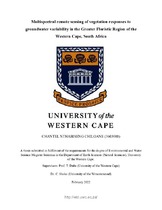| dc.contributor.advisor | Dube, Timothy | |
| dc.contributor.author | Chiloane, Chantel Nthabiseng | |
| dc.date.accessioned | 2022-02-08T10:23:23Z | |
| dc.date.available | 2022-02-08T10:23:23Z | |
| dc.date.issued | 2021 | |
| dc.identifier.uri | http://hdl.handle.net/11394/8678 | |
| dc.description | >Magister Scientiae - MSc | en_US |
| dc.description.abstract | Groundwater dependent vegetation (GDV) communities are increasingly threatened by the transformation of the natural environment to different land use/land cover, over-exploitation of groundwater resources and the proliferation of invasive species within the Cape Floristic Region (CFR). These changes affect the groundwater regime, level, and quality, which supports GDV. Natural resource managers often lack an understanding at appropriate scales of the nature of dependency of GDV to make informed sustainable decisions. This work thus assesses the spatial distribution of GDV and their responses to groundwater variability within the Cape floristic region from June 2017 to July 2018. To achieve this aim, firstly a literature review on the background of GDV, threats and the impact of climate change was assessed. | en_US |
| dc.language.iso | en | en_US |
| dc.publisher | University of Western Cape | en_US |
| dc.subject | Arid environments | en_US |
| dc.subject | Fynbos ecosystem | en_US |
| dc.subject | Satellite data | en_US |
| dc.subject | Vegetation health | en_US |
| dc.subject | Water scarcity | en_US |
| dc.title | Multispectral remote sensing of vegetation responses to groundwater variability in the greater floristic region of the Western Cape, South Africa | en_US |
| dc.rights.holder | University of Western Cape | en_US |

